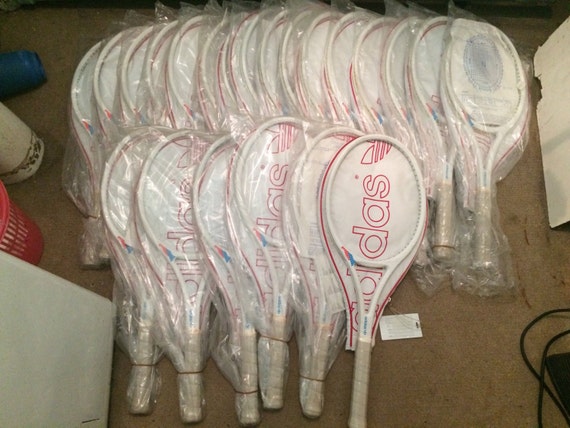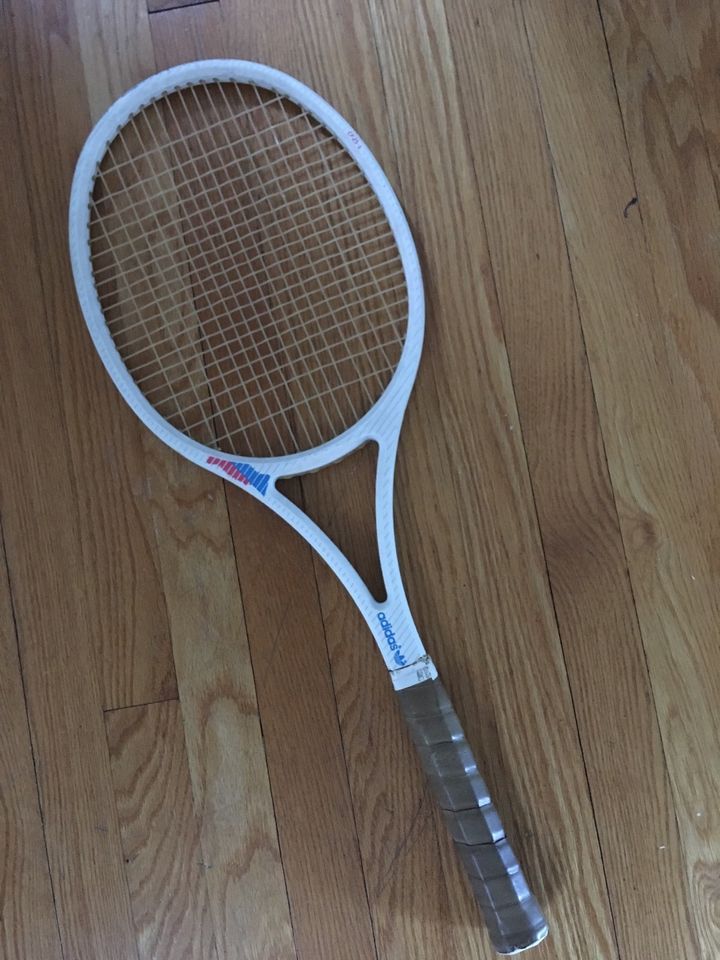You are using an out of date browser. It may not display this or other websites correctly.
You should upgrade or use an alternative browser.
You should upgrade or use an alternative browser.
What model of Adidas racquet is this?
- Thread starter Xfimpg
- Start date
Never 've seen anything like this.
I think this is really good one for the forum.
Not at all trying to stump you guys, I'm stumped myself.
retrowagen
Hall of Fame
Looks like the same mould as the CF-25.
Looks like the same mould as the CF-25.
No, different shape, also this one is a flat beam, CF-25 was not.
retrowagen
Hall of Fame
It's a CF-25L ("L" as in Lady?).
Want a "few" of these, go to https://www.etsy.com/ca/listing/399...21-white-rackets?ref=search_recently_viewed-1


vsbabolat
G.O.A.T.
It looks like 1986 all over againWant a "few" of these, go to https://www.etsy.com/ca/listing/399...21-white-rackets?ref=search_recently_viewed-1

Not only ladie's were white,
Don't think so. Mid-T looks more egg shape as i look at it now .
.
The shape looks like an Ivan Lendl GTX Mid-T but in white.
Don't think so. Mid-T looks more egg shape as i look at it now
Mid-T was like a Pro-T just with bigger head, all that squarish frame.The shape looks like an Ivan Lendl GTX Mid-T but in white.
Not only ladies' were white, check Adidas Concept Delta 1.Back in the 80s white racquets were typically for ladies, but Lendl played with the Kneissel Masters which was white, so that theory is out the door.
The color scheme reminds me Adidas Concept Delta1.It looks like 1986 all over again
joe sch
Legend
It's a CF-25L ("L" as in Lady?).
joe sch
Legend
It would be nice to know the weight of these lady rackets and the composition.
Maybe not very hefty or strong if that old graphite is too little/light for the lady hitter (not like Steffi
Below is what is listed:
I put on sale this very rare racket adidas Ivan Lendl model CF 25-L
It comes directly from the 1980s
It is new!
It is supplied with its record cover to mount the rope in German and french
There is even the right of warranty adidas
The handle is still under plastic
The cover is plastic
All in original packaging! never opened or unpacked! (just for the photo)
The gripe:L3 size: 4 3/8 L
Made in France
This racket is like the GTX Mid - T
Maybe not very hefty or strong if that old graphite is too little/light for the lady hitter (not like Steffi
Below is what is listed:
I put on sale this very rare racket adidas Ivan Lendl model CF 25-L
It comes directly from the 1980s
It is new!
It is supplied with its record cover to mount the rope in German and french
There is even the right of warranty adidas
The handle is still under plastic
The cover is plastic
All in original packaging! never opened or unpacked! (just for the photo)
The gripe:L3 size: 4 3/8 L
Made in France
This racket is like the GTX Mid - T
Purplemonster
Hall of Fame
Back in the 80s white racquets were typically for ladies, but Lendl played with the Kneissel Masters which was white, so that theory is out the door.
I have never quite understood the white racquet is for women thing. I could understand pink though.
I have never quite understood the white racquet is for women thing. I could understand pink though.
It must be because women are pure.
Sanglier
Professional
I just picked up a mystery Adidas of my own from a collector in North Carolina, who got it from either Hans or a German seller a while back. Based on the aerofoil beam profile and butt cap, I would date it to 1988-1989, but it is furnished with individual grommets and no bumper! As there is no model name displayed on the frame, I am tempted to identify this as a prototype, even though it is fully finished like a production racquet. In the past, I had come across other prototypes that came with individual grommets and no bumper, so maybe that's another reason to see it as a trial racquet.
But what exactly were they trying to accomplish with this design? It's like a quarter-finished Madeline Hauptman string job with an entirely conventional center. One of Hauptman's rationales for her string pattern was to keep the strings from shifting on impact, so as to produce a more consistent ball response and reduce string wear. By ignoring the center of the string bed where ball contact actually occurs, this quarter-madeline string job is almost as big a pain in the rear to produce as the full version, but provides none of the benefits where it matters! The only thing I can think of is that perhaps the extra spiderweb would stiffen the periphery and cause the string bed to behave as though it was under somewhat higher tension than normal (especially away from the center line), thus improving control to some degree compared to a conventionally-strung racquet? There is also (very) slightly more mass surrounding the point of impact from the extra strings, which might improve stability without deadening the string response? The fact that we don't see many of these racquets around (this is the first and only one I've come across so far) suggests that whatever benefit they expected to derive from this design ultimately failed to justify the cost of implementing the overly complex features.
Just to be clear, this is a factory string job on an NOS frame. The (white) grommets are different for the holes that contain extra diagonal strings. If anyone here knows what this model is called, please chime in!

But what exactly were they trying to accomplish with this design? It's like a quarter-finished Madeline Hauptman string job with an entirely conventional center. One of Hauptman's rationales for her string pattern was to keep the strings from shifting on impact, so as to produce a more consistent ball response and reduce string wear. By ignoring the center of the string bed where ball contact actually occurs, this quarter-madeline string job is almost as big a pain in the rear to produce as the full version, but provides none of the benefits where it matters! The only thing I can think of is that perhaps the extra spiderweb would stiffen the periphery and cause the string bed to behave as though it was under somewhat higher tension than normal (especially away from the center line), thus improving control to some degree compared to a conventionally-strung racquet? There is also (very) slightly more mass surrounding the point of impact from the extra strings, which might improve stability without deadening the string response? The fact that we don't see many of these racquets around (this is the first and only one I've come across so far) suggests that whatever benefit they expected to derive from this design ultimately failed to justify the cost of implementing the overly complex features.
Just to be clear, this is a factory string job on an NOS frame. The (white) grommets are different for the holes that contain extra diagonal strings. If anyone here knows what this model is called, please chime in!

Amazing racket. ThanksI just picked up a mystery Adidas of my own from a collector in North Carolina, who got it from either Hans or a German seller a while back. Based on the aerofoil beam profile and butt cap, I would date it to 1988-1989, but it is furnished with individual grommets and no bumper! As there is no model name displayed on the frame, I am tempted to identify this as a prototype, even though it is fully finished like a production racquet. In the past, I had come across other prototypes that came with individual grommets and no bumper, so maybe that's another reason to see it as a trial racquet.
But what exactly were they trying to accomplish with this design? It's like a quarter-finished Madeline Hauptman string job with an entirely conventional center. One of Hauptman's rationales for her string pattern was to keep the strings from shifting on impact, so as to produce a more consistent ball response and reduce string wear. By ignoring the center of the string bed where ball contact actually occurs, this quarter-madeline string job is almost as big a pain in the rear to produce as the full version, but provides none of the benefits where it matters! The only thing I can think of is that perhaps the extra spiderweb would stiffen the periphery and cause the string bed to behave as though it was under somewhat higher tension than normal (especially away from the center line), thus improving control to some degree compared to a conventionally-strung racquet? There is also (very) slightly more mass surrounding the point of impact from the extra strings, which might improve stability without deadening the string response? The fact that we don't see many of these racquets around (this is the first and only one I've come across so far) suggests that whatever benefit they expected to derive from this design ultimately failed to justify the cost of implementing the overly complex features.
Just to be clear, this is a factory string job on an NOS frame. The (white) grommets are different for the holes that contain extra diagonal strings. If anyone here knows what this model is called, please chime in!

retrowagen
Hall of Fame
Looks like a prototype development based on the Delta Plus mid. Late 80’s, for sure... right around the time adidas was curtailing its racquet making.
graycrait
Legend
@retrowagen , How many knots on that Adidas string bed?
Similar threads
- Replies
- 20
- Views
- 913

